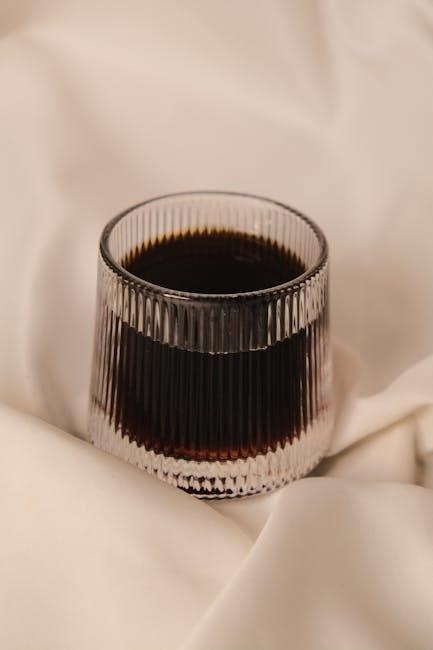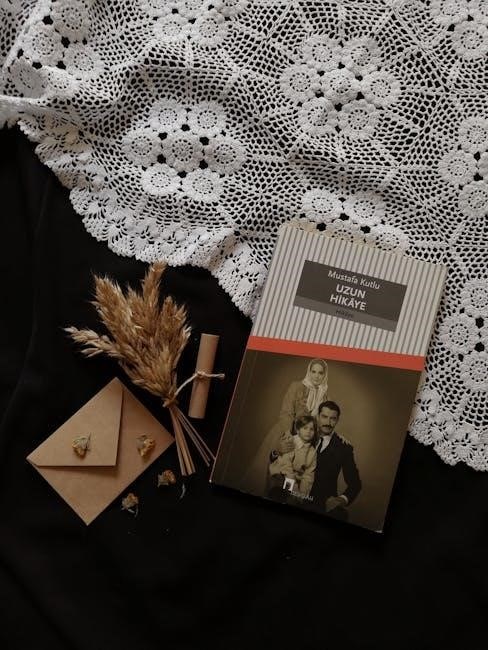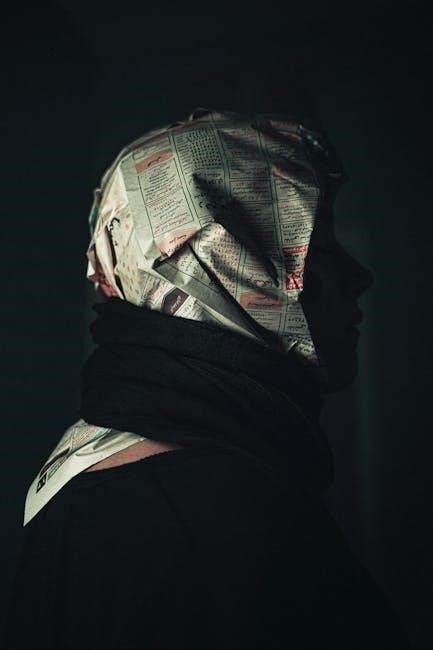Dark fabric transfer paper is specifically designed for use on dark-colored materials‚ offering vibrant‚ high-contrast image transfers. Unlike light transfer paper‚ it features a white or light background to ensure designs stand out clearly. This innovative solution is perfect for customizing clothing‚ accessories‚ and home decor items. It’s eco-friendly‚ safe‚ and bonds seamlessly with fabric‚ leaving a soft‚ flexible finish that withstands washing and wear without peeling.
1.1 What is Dark Fabric Transfer Paper?
Dark fabric transfer paper is a specialized heat transfer material designed for use on dark-colored fabrics. It features a white or light background that ensures vibrant‚ high-contrast image transfers. Unlike light transfer paper‚ it is specifically formulated to bond with dark materials‚ such as 100% cotton or cotton-poly blends‚ without requiring additional coatings. This paper is ideal for creating custom designs on clothing‚ accessories‚ and home decor items‚ offering a durable and long-lasting finish that withstands washing and wear.
1.2 Importance of Using the Right Transfer Paper for Dark Fabrics
Using the right transfer paper for dark fabrics is crucial for achieving vibrant‚ professional-looking results. Dark fabric transfer paper is specifically designed to ensure colors pop against darker backgrounds‚ while regular transfer paper may result in faded or invisible designs. Proper transfer paper ensures optimal adhesion‚ durability‚ and wash resistance‚ preventing peeling or fading over time. It’s essential for both cotton and cotton-poly blends‚ making it a must-have for custom projects on dark-colored materials.

Materials and Tools Needed
Gather dark fabric transfer paper‚ an inkjet printer‚ scissors‚ a household iron or heat press‚ and a flat‚ heat-resistant surface for smooth application and professional results.
2.1 Essential Supplies for the Transfer Process
To successfully apply dark fabric transfer paper‚ you’ll need a few key supplies. Start with high-quality dark fabric transfer paper designed for inkjet printers. A reliable inkjet printer is essential for printing your designs. You’ll also need sharp scissors or a craft cutter for precise cutting around your design. A household iron or heat press is required for transferring the image. Optional tools include a cutting mat for protection and a heat-resistant surface like an old t-shirt to cushion your fabric. Additionally‚ have tissue paper on hand to absorb excess ink during printing.
2.2 Recommended Printers for Dark Fabric Transfer Paper
For optimal results with dark fabric transfer paper‚ use an inkjet printer compatible with the paper type. Popular choices include Canon PIXMA‚ Epson SurePress‚ and HP DeskJet models‚ known for their vibrant color output. Ensure your printer supports borderless printing and high-resolution settings. The Canon MX922 is often recommended for its reliability. Always verify compatibility and test settings on regular paper before printing your final design on transfer paper to ensure the best results.

Preparing Your Design
Use graphic software to create high-contrast designs for dark fabrics. Ensure vibrant colors and clear details. Test print on regular paper before finalizing your transfer-ready design.
3.1 Design Considerations for Dark Fabrics
When designing for dark fabrics‚ prioritize high-contrast colors to ensure visibility. Use bold‚ vibrant hues and avoid fine details that may fade. Text should be large and clear‚ with no need for mirroring. Incorporate white or light backgrounds to enhance visibility. Avoid intricate designs that may lose clarity on dark materials. Test prints on scrap fabric ensure accuracy and color vibrancy before final application. This ensures your design stands out and retains quality on dark fabrics.
3.2 Software Tools for Creating Transfer-Ready Designs
Popular software tools like Canva‚ Adobe Illustrator‚ and Avery’s design tools help create transfer-ready designs. These programs allow for high-resolution image editing‚ ensuring vibrant colors and sharp text. Use built-in templates to simplify the process. Designs should be saved in formats like PNG or JPEG‚ with clear resolution for optimal printing. Test prints on plain paper ensure accuracy before transferring to fabric‚ guaranteeing professional results.
Printing Your Design
Print your design on dark fabric transfer paper using an inkjet printer. Ensure the paper is loaded correctly and settings are adjusted for optimal quality. No mirroring needed.
4.1 Step-by-Step Printing Instructions
Prepare your design‚ ensuring it’s the correct size and orientation; Dark fabric transfer paper does not require mirrored images.
Load the printer with dark fabric transfer paper‚ following the manufacturer’s guidelines for proper orientation.
Print a test page on regular paper to confirm alignment and color accuracy.
Print your design on the transfer paper using high-quality print settings for vibrant colors.
Allow the ink to dry completely before handling the paper to avoid smudging.
4.2 Tips for Achieving High-Quality Prints
For crisp‚ vibrant prints‚ use high-resolution designs and ensure proper printer settings. Select “mirror off” for dark fabric transfers and choose high-quality print mode. Use an inkjet printer compatible with transfer paper and test print on regular paper first. Avoid over-saturating colors‚ as this can bleed during transfer. Handle the paper carefully to prevent smudging. Allow ink to dry completely before handling or cutting‚ ensuring sharp‚ professional results every time.
Transferring the Design to Fabric
Transfer the design using a household iron or heat press for professional results. Preheat the fabric‚ place the transfer face-down‚ apply even heat and pressure‚ then peel carefully after cooling.
5.1 Using a Household Iron
Preheat your dry household iron to a high cotton setting without steam. Cover the ironing surface with an old t-shirt for cushioning. Place the fabric on a flat‚ heat-resistant surface. Position the transfer paper print-side down on the fabric. Iron thoroughly‚ applying firm pressure for 2-3 minutes. Allow the paper to cool completely before peeling it off slowly. For best results‚ test iron a small fabric sample first to ensure compatibility and avoid damage.
5.2 Using a Heat Press for Professional Results
Preheat the heat press to 300-350°F (150-175°C) with medium pressure. Place the fabric on the press surface‚ smooth and wrinkle-free. Position the transfer paper print-side down on the fabric. Cover with a protective sheet or parchment paper to prevent damage. Press for 10-15 seconds‚ ensuring even pressure. Allow the transfer to cool slightly before peeling the paper. For best results‚ avoid stretching the fabric during pressing and test settings on a scrap fabric first to ensure optimal adhesion.

Post-Transfer Care
Wash inside out in cold water‚ avoiding bleach or harsh detergents. Air dry to preserve vibrancy. Iron only on reverse side‚ never directly on the transfer.
6.1 How to Properly Peel the Transfer Paper
Allow the transfer to cool completely before peeling the paper. Start at one corner and peel slowly‚ ensuring the design remains intact. Avoid stretching the fabric during peeling. If the transfer lifts with the paper‚ re-iron the area and let it cool again. For best results‚ peel in one smooth motion‚ using the grab tab if provided. Proper peeling ensures a sharp‚ durable image on the fabric.
6.2 Washing and Drying Instructions
Allow 24 hours after transfer application before washing. Turn the garment inside out and wash in cold water using mild detergent. Avoid bleach or harsh chemicals. Gently scrub or use a soft cycle. Do not soak or wring the fabric. Air-dry or tumble dry on a low setting. Ironing is not recommended on the transferred area. Proper care ensures the design remains vibrant and durable for a long time.

Troubleshooting Common Issues
Common issues with dark fabric transfers include poor adhesion‚ faded colors‚ or incorrect peeling. Ensure proper printer settings‚ sufficient heat‚ and avoid multiple transfers on the same spot.
7.1 Solving Printing Problems
Printing issues with dark fabric transfer paper often stem from incorrect printer settings or low ink levels. Ensure your design is not mirrored‚ as dark transfers do not require mirroring. Check inkjet printer alignment and clean the printhead if necessary. Use test prints on regular paper to verify colors and clarity before printing on transfer paper. Ensure the correct paper type is selected in your printer settings. If issues persist‚ consult your printer’s user manual or use high-quality ink cartridges for optimal results.
7.2 Fixing Transfer Application Mistakes
If the transfer doesn’t adhere properly‚ reapply heat with a household iron or heat press‚ ensuring even pressure. For peeled edges‚ gently press them back using a lower temperature. Mistakes during peeling can be minimized by removing the paper slowly and at a 45-degree angle. If the design lifts off‚ restart the process with fresh transfer paper. Always pre-iron fabrics to remove wrinkles and moisture‚ ensuring optimal adhesion. Proper alignment and consistent heat application are key to avoiding errors.
Advanced Tips and Tricks
Master advanced techniques for professional results with dark fabric transfer paper. Use heat presses for vibrant colors and precise application. Opt for high-quality fabrics like cotton for optimal adhesion. Experiment with layering designs and software tools for intricate patterns. Ensure precise alignment for flawless transfers every time.
8.1 Optimizing Fabric Choice for Best Results
For optimal results with dark fabric transfer paper‚ choose 100% cotton or high cotton-blend fabrics‚ as they absorb the transfer best. Avoid stretchy or synthetic fabrics‚ as they may distort designs. Pre-wash and dry fabrics to remove finishes that interfere with adhesion. Smooth‚ tightly woven fabrics work best‚ while thick or textured materials may not hold details well. Test a small scrap first to ensure compatibility and desired results‚ ensuring vibrant‚ long-lasting transfers.
8.2 Layering and Complex Designs
Layering and complex designs can be achieved with dark fabric transfer paper by using a heat press for precise control. Start with the base layer‚ ensuring it adheres fully before adding subsequent layers. Allow each layer to cool slightly to prevent damage. For intricate multicolor designs‚ use software to separate colors and print individually. This method ensures vibrant‚ detailed transfers that maintain fabric softness and flexibility. Proper layering enhances durability and visual appeal‚ making it ideal for professional and creative applications.
Environmental and Safety Considerations
Eco-friendly dark fabric transfer papers are available‚ made from recyclable materials. Use non-toxic inks and follow safety guidelines to avoid heat-related accidents. Always iron in a well-ventilated area.
9.1 Eco-Friendly Transfer Paper Options
Eco-friendly dark fabric transfer papers are made from recyclable materials‚ reducing environmental impact. These options use biodegradable components and non-toxic inks‚ ensuring safer use while maintaining vibrant results. Many brands now offer sustainable alternatives that minimize waste and chemical emissions. Choosing eco-conscious transfer papers supports environmentally responsible crafting and fashion projects‚ aligning with growing demands for greener products. Opting for these options helps preserve the planet without compromising on quality or design integrity.
9.2 Safety Precautions When Using Heat
When using heat transfer methods‚ ensure the iron or heat press is preheated to the correct temperature without steam. Always iron on a heat-resistant surface‚ such as an old t-shirt‚ to prevent scorching. Keep flammable materials away and avoid overheating‚ as it can damage fabric or cause burns. Use caution when handling hot tools and keep children away. Allow the fabric to cool before handling to avoid burns. Proper ventilation is also recommended to prevent inhaling fumes from the transfer process.
Dark fabric transfer paper offers an easy‚ effective way to create professional‚ personalized designs on dark materials. With proper techniques‚ achieve vibrant‚ long-lasting results that inspire creativity and confidence.
10.1 Final Thoughts on Using Dark Fabric Transfer Paper
Using dark fabric transfer paper is a convenient and effective way to create professional-quality designs on dark materials. With proper preparation and application‚ you can achieve vibrant‚ long-lasting results. Always follow instructions carefully‚ test designs on scrap fabric first‚ and ensure proper heat settings for optimal outcomes. The right tools and techniques make the process straightforward‚ allowing you to explore creative possibilities confidently; This method is ideal for both beginners and experienced crafters‚ offering reliable results every time.
